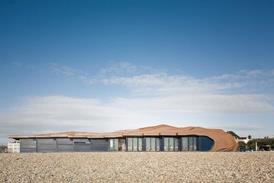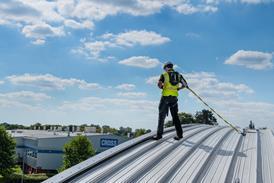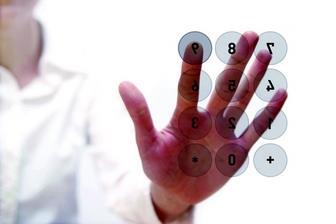This month Davis Langdon Engineering Services compares the features of various methods of access control for both people and vehicles
Access control in and around buildings is concerned with allowing the free flow of authorised people while denying access to unauthorised visitors. This includes the control and management of vehicles as well as pedestrian flow.
Requirements range from simple remote systems for perimeter doors to a sectorised installation with flexible access privileges and usage records. Sensitive areas may need special protection and access may be required by different people to different areas at different times. It may also be important to monitor and have a record of who went where and when.
It is essential that these issues are thought about in the early stages of the project to ensure they are fully integrated into the overall M&E services design. This is particularly pertinent in buildings where security is an important factor, such as airports and banks.
The benefits of an effective, robust access control system include:
- The generation of valuable management information. Knowledge of people’s movements can help planning to achieve greater efficiencies.
- Securing certain areas of a building, where appropriate.
- Protection of employees, visitors, property and sensitive information.
- Integration with other security systems within the building, to enhance the overall level of protection.
- Assistance with car park management.
- Help in satisfying the requirements of the Disability Discrimination Act.
- Controlling access to other facilities or equipment, such as vending machines or computers.
This article is a brief overview of the typical issues that need to be considered when formulating an access control strategy for a new development.
Vehicle management
The sophistication and cost of vehicle management systems vary according to the number of cars to be controlled, whether a fee is charged, the type and number of entrances and the level of security required. For instance, retail and airport environments may have very different needs from commercial office buildings.
The typical elements of a vehicle management system are:
Barriers
The most common means of managing vehicular flow is by using traffic barriers, an often overlooked but vital part of any car park management system. Groundworks are frequently completed before anyone thinks about the barrier system, which adds cost and time to the installation.
Barriers can be electro-mechanical or hydraulic. The latter offer a longer life and are robust and reliable. The former are cost-effective to buy but more expensive to operate. For sites with high traffic volumes, it is worth considering barriers with built-in loop detectors and fast cycle times.
Barriers can be linked to access control or traffic counting systems. They can also be automated using a tagging system on the cars of office staff.
Rising bollards
Rising bollards provide a more substantial barrier for controlling access and urban traffic and protecting sensitive areas with minimal visual intrusion. They can be manually, electrically or pneumatically operated and controlled to rise and fall on impulse from a transmitter or access control system. They can also be key operated.
Parking management systems
The most common system for fee-paying car parking is time based. The system uses magnetic strip cards to hold access rights and validity-time data and has an entry station, pay machines and an exit station. From the information stored on the card, the system validates entry time, calculates the fee and issues the card for exit. Cards are captured for reissue and all transactions can be logged for instant verification and later report generation.
Pedestrian access management
The key considerations when formulating a pedestrian access control strategy are:
- location and number of sites
- number of areas and points to be controlled
- layout of building
- number and turnover of occupants
- number and access required internally for visitors
- disabled access requirements
- how the system is to be managed internally
- future growth
- level of security required incorporation of other functions such as cashless vending.
The range of options available to manage the access and movement of people in and around buildings is summarised briefly below. The level of sophistication and security will depend on assessment of the factors above.
Coded entry systems
This is simply where a standard four-digit code is set to allow certain staff access through a particular door or doors. There is a keypad outside the door with a power supply and electric lock on the secure side of the door. Battery back-up should be provided in the event of a power failure.
This can also form part of a door intercom system.
Door intercom systems
These are now considered essential for any small to medium-size office in the UK. Audio systems consist of an intercom panel at the entrance connected to a door phone in the office and an electric lock.
Video systems may be considered more appropriate, which means the addition of a camera in the entrance panel (with infra-red lighting to improve image resolution) and a monitor on the receiving unit.
Turnstiles
Controlling access through the main entrances of a building is fundamental to providing a secure environment. Even with access control on a door it is possible for somebody to “tailgate”, thereby undermining the security system.
Greater security and control can be achieved by installing turnstile access at the main entry points of a building. There are mid-height, full-height or monitored versions. Factors to consider in the choice of the most appropriate type include:
- The number of people using the building. One lane is enough for 150 to 200 people, assuming the turnstiles are set up to be bi-directional.
- Are they required to fail to an open position on a fire alarm activation?
- Means of activation (normally card).
- Requirement to be alerted if tailgating takes place. Some of the systems offer this feature and can provide an impulse to a local alarm, CCTV camera etc.
- Is an override to the system with a remote push button required?
Automatic doors – card access
Reader technologies provide the interface with the access control system and vary considerably. Swipe and access cards are capable of allowing or disallowing access to specific areas depending on the level of access required/authorised.
Swipe cards, although regarded by many as old-fashioned, rely on a low-cost basic technology which has proved over the years to be very effective. �ǿմ�ý users carry a small card which, when swiped through the reader, allows them in if the card is valid for that day and time.
Where high user populations are likely, this can be an economical option as the cost of the cards is low. The system can be specified for buildings with many card readers, linked back to a PC, thus allowing individual cards to be timed and controlled and providing a full audit trail of who went where and when.
Proximity card readers are becoming the norm. Security is extremely high thanks to the encryption of data on the cards. It is possible to amalgamate photo-ID images and time recording into the same system. The card can be read a few inches away from the reader. As it is a non-contact technology there is no wear and tear on the reader or the cards.
The new generation of smartcard readers allows programming of individual memory sectors within the card. The basic difference between smartcard readers and conventional proximity or swipe card readers is that the former can be encrypted with data and used for other services such as cashless vending and photocopying.
Hands-free entry is possible as the card or fob can unlock the door as the user walks towards it, thanks to a signal picked up by the proximity card reader. Each card has a unique signal and can be individually recognised so the appropriate action can be taken when the card comes into range.
The system works through solid walls, so can be out of sight, and makes disabled access easier as no action is required by the card bearer. This approach is also popular for medical applications as the system is non-contact, hygienic and quick. It can accommodate long- or short-range reading technology. Photographic imaging and links to CCTV equipment can be used to provide a higher degree of security.
Fingerprint access is probably the most advanced form of control available today because it does not rely upon a number or a card but on the person’s biological identity. This raises the security level significantly.
There are many biometric access systems, including hand, face, retina and voice recognition, as well as many combinations. The two most widely used are hand shape and fingerprint readers. Both systems can be very useful in highly secure areas, and are available with time and attendance software that makes it possible to determine how long a person has been on site, for both economic and safety reasons.
The biometric hand reader requires users to present a hand to the unit and after three sample reads it holds the shape in its memory. When users wish to gain access they tap in their four-digit PIN numbers and present their hands, which are then compared to the records on the machine. The fingerprint reader works in an almost identical manner but is smaller.
It can be built into a door or wall.
These systems can be linked to card access systems, thus requiring staff to present their card and hand to gain entry.
The latest development allows the fingerprint to be stored within the card rather than in the client’s database. This makes the system less vulnerable to data loss.
Door entry systems
These allow multiple card readers to be connected together to a single point of control. The software allows the card holders to be set up for different access levels and time frames to provide flexible control over cards, doors and times.
Automatic doors
Automatic door operators help to achieve compliance with the Disability Discrimination Act by making some provision for disabled access. The units can be push-button entry or linked to an access control system such as a card reader, keypad or intercom so when the visitor arrives, the door will not only unlock but automatically open and close. The industry is moving toward 24v operators as opposed to 230v as they are more energy efficient and safer in operation.
The units can also be set to open on impulse from a fire alarm activation and stay open if necessary to assist in ventilation and evacuation procedures.
The systems need to be set up in accordance with BS7036 to ensure they are correctly specified for the purpose and are fitted with the appropriate safety circuits. These can include presence detectors, hinge guards to stop fingers getting caught and other safeguards.
Indicative costs
Separate breakdowns are provided for a car park management system (Table 1) and an access control system (Table 2). These indicate the likely cost for large schemes.
The car park management system is for a town-centre shopping complex that has purpose-built parking facilities with numerous barriers and pay stations.
The access management system is for an office building in central London with a gross area of 50,000m2 over 12 floors, including one basement level. The costs include access control to basement and ground-floor levels only, with on-floor access control to tenants’ areas being part of the fit-out works. Primary containment is by others and allowance is made for secondary containment from this to the point of connection on the basement and ground floors.
Downloads
Table 1: Car Park Management System
Other, Size 0 kbTable 2: Access control system
Other, Size 0 kb
Source
�ǿմ�ý Sustainable Design


















No comments yet